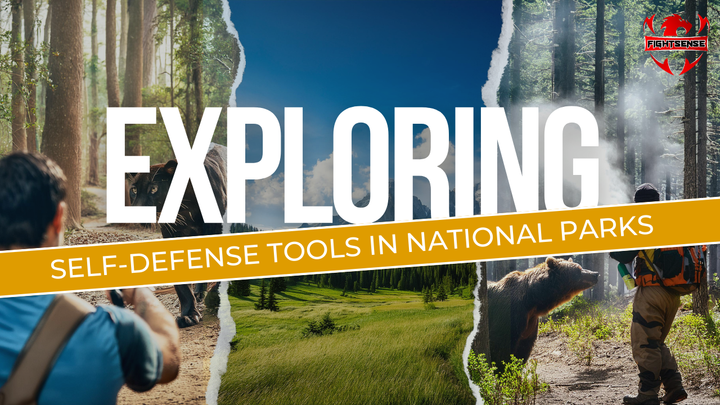Your Guide to Self Defense Tools for National Park Adventure
27th Jul 2024
Self Defense Tools for National Park visits are essential for staying safe while enjoying nature’s beauty. National parks offer breathtaking landscapes, peaceful surroundings, and unique wildlife encounters, but they also present risks, especially from animals. Understanding which personal protection tools are allowed and how to use them responsibly is crucial for any outdoor adventurer.
This guide covers everything from bear spray to non-lethal devices and other safety equipment, helping you stay prepared and secure during your park adventures.
Keynotes
-
Carry Essential Safety Gear: Pepper spray, bear spray, alarms, and whistles help stay protected in national parks.
-
Know the Rules: Check park and state regulations before carrying self-defense tools.
-
Use Tools Responsibly: Knives, firearms, and pepper spray should be used correctly and only when necessary.
-
Prevent Wildlife Encounters: Noise-making devices like bells and horns alert animals and reduce surprises.
-
Training Matters: Practice using your safety tools to ensure effective and confident use during emergencies.
Bear Spray – Self Defense Tools for National Park
Bear spray is a must-have for anyone venturing into bear country. It contains oleoresin capsicum, which irritates the animal's eyes and respiratory system, deterring it without causing permanent harm.
- Legality and Regulations: Bear spray is generally legal in most national parks, but there are exceptions. For example, it is allowed and recommended in Yellowstone and Glacier National Parks but prohibited in Yosemite and Sequoia & Kings Canyon.
- Usage Guidelines: Keep bear spray readily accessible, know how to use it, and practice beforehand.
Firearms: Understand the Rules
The rules for carrying firearms in national parks changed in 2010, allowing visitors to carry firearms if they comply with state laws where the park is located. However, federal facilities within the parks still prohibit firearms.
- General Rules: Research state-specific laws before your trip.
- Usage: Use knives responsibly for tasks like food preparation or gear repair, not as primary self-defense tools.
Knives and Blades: Practical Tools with Restrictions
Knives are versatile self defense tools for outdoor activities but come with restrictions in national parks.
- Types Allowed: Small utility knives and multitools are generally permitted. Larger or tactical knives may have restrictions.
- Usage: Use knives responsibly for tasks like food preparation or gear repair, not as primary self-defense tools.
Pepper Spray – Self Defense Tools for National Park
While bear spray is specific for large animals, regular pepper spray can be used for personal protection against human threats.
- Legality: Check state laws, as they govern the use of pepper spray.
- Effectiveness: Suitable for self-defense against human attackers, less effective on large animals compared to bear spray.
Noise-Making Devices: Preventing Encounters
Noise-making devices like bear bells and horns are effective in alerting wildlife to your presence, reducing the likelihood of surprise encounters.
- Effectiveness: Highly recommended in bear country to alert animals and prevent close encounters.
- Types: Bear bells, air horns, and even loud talking can be effective.
Stun Guns and Tasers: Know the Laws
Stun guns and Tasers are additional self-defense tools, but their legality varies widely.
- Legality: Check specific park and state regulations before carrying these devices.
- Usage: Understand how to use them effectively for personal protection.
Conclusion
Self Defense Tools for National Park safety require understanding both the rules and proper use of protection devices. Whether carrying bear spray, a knife, a firearm, or other deterrents, knowing their legality and correct operation is essential for a safe and enjoyable outdoor adventure. Always review specific park regulations before your trip and equip yourself with the right tools and knowledge for maximum protection.
FAQS
1. What safety gear should I carry while visiting national parks?
When exploring national parks, hikers often rely on personal safety gear like pepper spray, alarms, or whistle tools to stay protected in remote areas.
2. Are protective devices allowed inside national park trails?
Most national parks permit non‑lethal protection items such as sound alarms or deterrent sprays, but rules vary—always check the park’s official guidelines.
3. Which personal protection items work best against wildlife encounters?
For wildlife-heavy parks, bear spray, whistles, or noise‑making devices are commonly recommended to deter animals without causing harm.
4. Do I need any training to use park‑friendly protection tools?
Basic practice is helpful. Items like safety sprays or handheld alarms usually come with simple instructions, making them easy for beginners to use.
5. What is the safest option to carry for solo hikers in national parks?
Solo visitors often choose lightweight protection gear such as pocket alarms, deterrent sprays, or emergency whistles that are easy to access in stressful situations.

